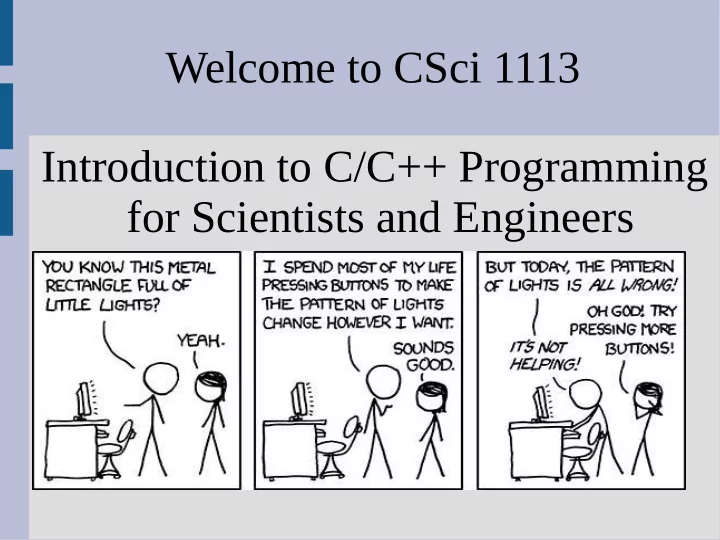

Welcome to CSci 1113 Introduction to C/C++ Programming for Scientists and Engineers
Instructor (me) James Parker Shepherd Laboratories 391 Primary contact: jparker@cs.umn.edu
TAs Karthik Unnikrishnan, Prashanth Venkatesh, Jackson Benning, Yanjun Cui, Mitchell Dillon, Skye Gagnon, Jacob Hammer, Samuel Highbargin, Lin Huynh, Shane Jung, Jin Hong Kuan, Jan-Wei Lim, Haoran Liu, Ying Lu, Sophia Manicor, Andrew McCullough, Adam McCune, Kyle Meng, Brandon Nee, Tanner Skluzacek, Antonio Turley, Ruobing Wang, Kaiwei Wu, Yuyang Xiao, Songyu Yan, Lei Zhang, Xintong Zhang
Questions? Direct questions to: Canvas forum discussion jparker@cs.umn.edu
Textbook Problem Solving With C++, Walter Savitch, 10 th edition
Sister course: CSci 1115 This course is an “introduction” (from start), but many find it difficult We started to run a supplementary course to provide additional help: CSci 1115(Th 6pm)
Sister course: CSci 1115 This course is an “introduction” (from start), but many find it difficult We started to run a supplementary course to provide additional help: CSci 1115(Th 6pm)
Sister course: CSci 1115 This course is an “introduction” (from start), but many find it difficult We started to run a supplementary course to provide additional help: CSci 1115(Th 6pm) Me Daniel
Sister course: CSci 1115 This course is an “introduction” (from start), but many find it difficult We started to run a supplementary course to provide additional help: CSci 1115(Th 6pm) -group problem solving
Sister course: CSci 1115 This course is an “introduction” (from start), but many find it difficult We started to run a supplementary course to provide additional help: CSci 1115(Th 6pm) -group problem solving -free food!
CSELabs account You need a CSELabs account to participate in labs in this course Lab attendance is mandatory (please make an account!)
https://cseit.umn.edu/
https://cseit.umn.edu/
https://cseit.umn.edu/
https://cseit.umn.edu/
CSELabs account CSELabs account used in lab (first lab ensures account working) Register ASAP Problems? Bug operator@cselabs.umn.edu
Class website www.cs.umn.edu/academics/classes Or google “umn.edu csci class” Syllabus, schedule, other goodies Canvas page will have grades and (maybe) homework submissions
Class website Canvas also has a link to the website:
www.cs.umn.edu
Syllabus 15% Labs 30% Homework (due Fridays) 5% Quiz (Feb. 19) 10% Midterm 1 (March 4) 15% Midterm 2 (April 15) 25% Final (Monday May 11, 10:30am to 12:30am in this room)
Syllabus Each week there will be either a homework due or a test Homework is due Fridays at 11:55 P.M. (more info to come) Late homework is not accepted, but we will drop the lowest one
Syllabus Labs can be checked off up until a week after the lab (“warm up” Qs must be checked off in your lab) Homework must be done by yourself Don't cheat Really... don't cheat
Homework Homework will be both a creative and problem solving endeavor: Lego example Build a castle with: -4 walls enclosing -Door -At least one tower (higher than wall)
Homework
Exams All exams will be open book/notes Electronic notes okay (no memorization) You cannot : 1. Use the internet (no typing) 2. Compile/run programs 3. Talk to or copy from others
Syllabus Grading scale: 77% C+ 93% A 73% C 90% A- 70% C- 87% B+ 67% D+ 83% B 60% D 80% B- Below F
Schedule Ch. 1: Introduction, Programs, Compilers Ch. 2: Input/Output, Data, Expressions Ch. 3: Control Flow (if and loops) Ch. 4, 5: Functions (return values) Ch. 6: File I/O Ch. 7, 8: Arrays and Strings Ch. 9: Pointers and Dynamic Arrays Ch. 10&11: Classes and Operator Overloading Ch. 14&15: Recursion & Inheritence
Syllabus Any questions?
What can I program? If you can think of an explicit process (of simple steps) to solve your problem, then it can be programed
Banana Nut Bread Directions 1. Preheat the oven to 350°F (175°C). 2. Mix butter into the mashed bananas in a large mixing bowl. 3. Mix in the sugar, egg, and vanilla. 4. Sprinkle the baking soda and salt over the mixture and mix in. 5. Add the flour and nuts last, mix. 6. Pour mixture into a buttered 4x8 inch loaf pan. 7. Bake for 1 hour. Cool on a rack.
Repetitive tasks If you feel like a mindless zombie when you do it a lot, you can probably program it.
Repetitive tasks
Repetitive tasks
Repetitive tasks
ATMs How do you get change for $18.26 with the least amount of bills and coins?
Auto leveling?
Software vs Hardware Software - the more intangible code on a computer Hardware - the physical Parts of the computer
Hardware interaction CPU Input Output Memory
Memory addressing Data is stored in “addresses” inside the memory Later in this class, we will use these addresses to manipulate and share data
Memory addressing
Object oriented programming OOP - focus on data and how they interact To make algorithms for OOP, it is often useful to identify the data you are working with and their relationships before programming
Object oriented programming Data for... Banana nut bread? ATM? Ball game?
Object oriented programming Data for... Banana nut bread? Ingredients ATM? Ball game?
Object oriented programming Data for... Banana nut bread? Ingredients ATM? Dollars & coins Ball game?
Object oriented programming Data for... Banana nut bread? Ingredients ATM? Dollars & coins Ball game? Balls & mouse
Object oriented programming Data for... Banana nut bread? Ingredients ATM? Dollars & coins Ball game? Balls & mouse Lots of pixels (tiny color dots)
Recommend
More recommend